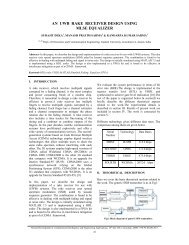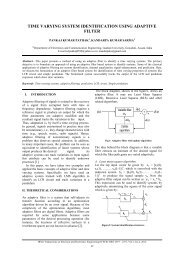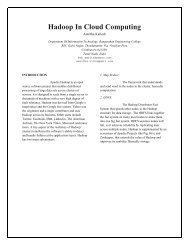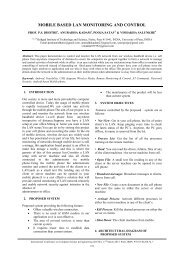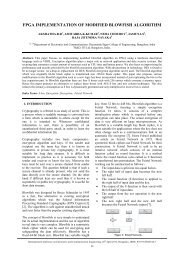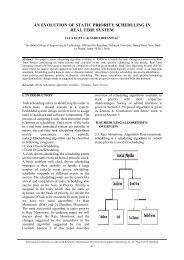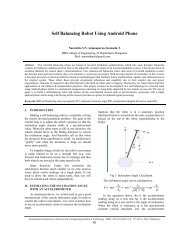HAKI-NFC Based Android Application - IRNet Explore
HAKI-NFC Based Android Application - IRNet Explore
HAKI-NFC Based Android Application - IRNet Explore
You also want an ePaper? Increase the reach of your titles
YUMPU automatically turns print PDFs into web optimized ePapers that Google loves.
<strong>HAKI</strong>-<strong>NFC</strong> <strong>Based</strong> <strong>Android</strong> <strong>Application</strong><br />
Fig. 4.7 : Write Plaintext<br />
The Basic Principle for Writing to a Tag will be to<br />
encapsulate the bytes of data into a NdefRecord first.<br />
e.g.<br />
For a record containing text<br />
(1) NdefRecord record = new NdefRecord<br />
(NdefRecord.TNF_WELL_KNOWN,<br />
NdefRecord.RTD_TEXT, new byte[0], data);<br />
After this the NdefRecords thus created are<br />
encapsulated into NdefMessage.<br />
(2) NdefMessage textMessage = new NdefMessage<br />
(new NdefRecord [] {record});<br />
This NdefMessage is then written onto tag through<br />
radio waves when tag and phone is within a range of<br />
4cm. For information on types of NdefMessage that can<br />
be written refer [8] .<br />
B. Helping Visually Impaired<br />
<strong>HAKI</strong> will help visually impaired people with an<br />
intuitive way to select objects. <strong>HAKI</strong> will make the<br />
retail experience more accessible and simple for blind<br />
and partially sighted. Using phones it will help them get<br />
product information — including the name of a product,<br />
its price and details of what it contains in voice based<br />
description form— by reading an <strong>NFC</strong> tag. <strong>HAKI</strong> can<br />
also be used at home where <strong>NFC</strong> stickers can be stacked<br />
to medicine, syrups, CD’s etc. So that<br />
How Will It Work?<br />
<strong>NFC</strong> tag will be containing text information<br />
regarding object description.<br />
For example- “Product Name: Music CD<br />
Quantity: 1<br />
Price: 150 Rupees”<br />
“Product Name: HP Laptop<br />
Processor: AMD turion<br />
RAM: 4GB<br />
Price: 40,000 Rupees”<br />
Huge information can be written as the tag memory<br />
size is available in different sizes.<br />
Now with the help of <strong>HAKI</strong>, when the mobile is<br />
brought near the tag, android’s tag dispatch system<br />
again does it works as discussed above. The activity<br />
which is supposed to handle this intent is has its intent<br />
filter as shown<br />
<br />
<br />
<br />
<br />
Mime type specifies the activity to start only if the<br />
tag contains text data. How Tag Data is read is already<br />
discussed in section 4.1.2. After detecting the tag,<br />
instantly the textual information is processed and<br />
converted into speech with the help of android text-tospeech<br />
engine [8] . Then the phone will just read out the<br />
product description on simply tapping the phone to the<br />
tag.<br />
C. Monitoring the attendance of employee<br />
Employees I.D. card will be containing his name<br />
and I.D. This information can be used to mark his<br />
attendance. All that an employee has to do is to tap his<br />
phone (or I.D. Card) on <strong>NFC</strong> reader. His I.D. will be<br />
read and will be used to mark his attendance. Again the<br />
principle of reading from tag will be same as section<br />
4.1.2. The attendance database will be stored on a<br />
remote server. PHP will be used as middleware. The<br />
remote database will be that of MySQL.<br />
Once Name and I.D. is read by using <strong>NFC</strong>,<br />
appropriate Activity will be launched by <strong>Android</strong> Tag<br />
Dispatch System as discussed in section 4.1.2. This<br />
Activity will be used for connecting to remote database<br />
and updating it. The main reason for taking a scripting<br />
language like PHP is because of the interaction with<br />
databases it can offer. For making connection to PHP<br />
script, we will use HTTP protocol from the android<br />
system. If we talk about client-server architecture, client<br />
<strong>IRNet</strong> Transactions on Computer Science and Engineering<br />
18







